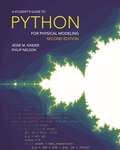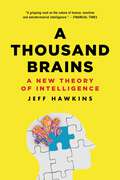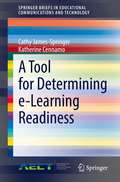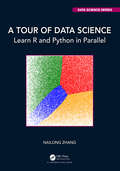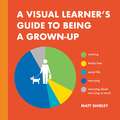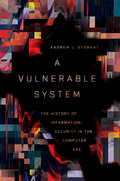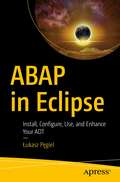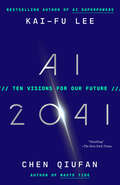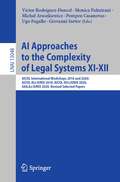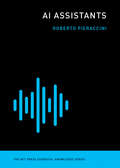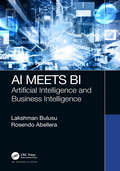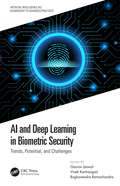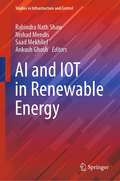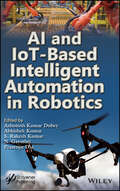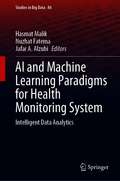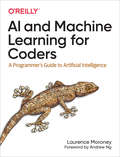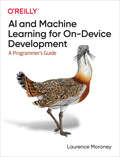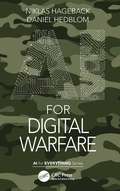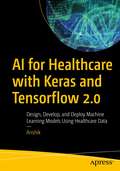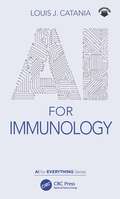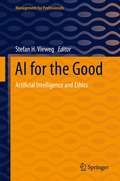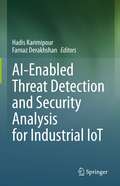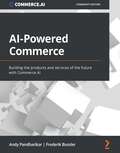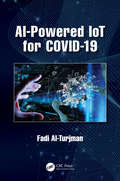- Table View
- List View
A Student's Guide to Python for Physical Modeling: Second Edition
by Jesse M. Kinder Philip NelsonA fully updated tutorial on the basics of the Python programming language for science studentsPython is a computer programming language that has gained popularity throughout the sciences. This fully updated second edition of A Student's Guide to Python for Physical Modeling aims to help you, the student, teach yourself enough of the Python programming language to get started with physical modeling. You will learn how to install an open-source Python programming environment and use it to accomplish many common scientific computing tasks: importing, exporting, and visualizing data; numerical analysis; and simulation. No prior programming experience is assumed.This guide introduces a wide range of useful tools, including:Basic Python programming and scriptingNumerical arraysTwo- and three-dimensional graphicsAnimationMonte Carlo simulationsNumerical methods, including solving ordinary differential equationsImage processingNumerous code samples and exercises—with solutions—illustrate new ideas as they are introduced. This guide also includes supplemental online resources: code samples, data sets, tutorials, and more. This edition includes new material on symbolic calculations with SymPy, an introduction to Python libraries for data science and machine learning (pandas and sklearn), and a primer on Python classes and object-oriented programming. A new appendix also introduces command line tools and version control with Git.
A Thousand Brains: A New Theory of Intelligence
by Jeff HawkinsA bestselling author, neuroscientist, and computer engineer unveils a theory of intelligence that will revolutionize our understanding of the brain and the future of AI. For all of neuroscience's advances, we've made little progress on its biggest question: How do simple cells in the brain create intelligence? Jeff Hawkins and his team discovered that the brain uses maplike structures to build a model of the world-not just one model, but hundreds of thousands of models of everything we know. This discovery allows Hawkins to answer important questions about how we perceive the world, why we have a sense of self, and the origin of high-level thought. A Thousand Brains heralds a revolution in the understanding of intelligence. It is a big-think book, in every sense of the word.
A Tool for Determining e-Learning Readiness (SpringerBriefs in Educational Communications and Technology)
by Katherine Cennamo Cathy James-SpringerThis book presents a tool to determine e-learning readiness in workplace organizations. It offers a case study of the design and development process and outlines factors to be taken into account to determine e-learning readiness. It details the four objectives of this tool: to highlight specific parameters for determining e-learning readiness, to provide a systematic process to determine the readiness of an organization, to enable flexibility for the environmental context, and to capture the interrelatedness of the many areas in the organization. Next, it discusses the main element of the tool: surveys that are used to facilitate collection of data on organizational, learner and technology readiness. The book concludes with a look at practical ways of using the information gathered from the data produced.
A Tour of Data Science: Learn R and Python in Parallel (Chapman & Hall/CRC Data Science Series)
by Nailong ZhangA Tour of Data Science: Learn R and Python in Parallel covers the fundamentals of data science, including programming, statistics, optimization, and machine learning in a single short book. It does not cover everything, but rather, teaches the key concepts and topics in Data Science. It also covers two of the most popular programming languages used in Data Science, R and Python, in one source. Key features: Allows you to learn R and Python in parallel Cover statistics, programming, optimization and predictive modelling, and the popular data manipulation tools – data.table and pandas Provides a concise and accessible presentation Includes machine learning algorithms implemented from scratch, linear regression, lasso, ridge, logistic regression, gradient boosting trees, etc. Appealing to data scientists, statisticians, quantitative analysts, and others who want to learn programming with R and Python from a data science perspective.
A Visual Learner's Guide to Being a Grown-Up
by Matt ShirleyBased on Matt Shirley's popular Instagram account, this smart and hilarious guide is a collection of tables, lists, and charts for all the visual learners out there striving to be a successful grown-up.We all know the particular pain that comes with having to be an actual adult, whether it's resetting your internet password on ten different sites, yearning for an excuse to get out of the plans your wife made for you months ago, or the anxiety that comes from forcing yourself to work out again.When Matt Shirley became fed up with being a grown-up, he started drawing charts as a more fun and efficient way to cope with his frustrations, and stuck them up on Instagram where they became an instant hit. Packed with over one hundred charts, graphs, diagrams, and infographics—with 50 percent brand-new material—this hilarious collection vows to explain everything you need to know about how to be a grown-up, covering work, family, and friends, to dating, breakups, and more.From explaining the cycle of adulthood to decoding the pros and cons of first dates to understanding the corporate lingo translator, Shirley's charts cut to the core of how to be an adult in the funniest possible way.
A Vulnerable System: The History of Information Security in the Computer Age
by Andrew J. StewartAs threats to the security of information pervade the fabric of everyday life, A Vulnerable System describes how, even as the demand for information security increases, the needs of society are not being met. The result is that the confidentiality of our personal data, the integrity of our elections, and the stability of foreign relations between countries are increasingly at risk.Andrew J. Stewart convincingly shows that emergency software patches and new security products cannot provide the solution to threats such as computer hacking, viruses, software vulnerabilities, and electronic spying. Profound underlying structural problems must first be understood, confronted, and then addressed.A Vulnerable System delivers a long view of the history of information security, beginning with the creation of the first digital computers during the Cold War. From the key institutions of the so-called military industrial complex in the 1950s to Silicon Valley start-ups in the 2020s, the relentless pursuit of new technologies has come at great cost. The absence of knowledge regarding the history of information security has caused the lessons of the past to be forsaken for the novelty of the present, and has led us to be collectively unable to meet the needs of the current day. From the very beginning of the information age, claims of secure systems have been crushed by practical reality.The myriad risks to technology, Stewart reveals, cannot be addressed without first understanding how we arrived at this moment. A Vulnerable System is an enlightening and sobering history of a topic that affects crucial aspects of our lives.
ABAP in Eclipse: Install, Configure, Use, and Enhance Your ADT
by Łukasz PęgielMaster Advanced Business Application Programming (ABAP) Development Tools by installing, customizing, and using them in Eclipse.The book begins by describing the installation and customization of ABAP Development Tools in Eclipse and how to adjust the IDE to meet your requirements. You will discover the ABAP Development Tools functionality that helps you be more efficient in programming in the ABAP language, including refactoring, markers, quick fixes, unit testing, and much more. Moving on, you will cover the available Eclipse plugins that you can use with ABAP Development Tools to make Eclipse even more developer-friendly: ABAP Continuous Integration and ABAP Extensions. Finally, you will learn how to create your own Eclipse plugin that is integrated with ABAP Development Tools.This book is perfect for every ABAP developer who wants to get started with ABAP Development Tools in Eclipse, as well as experienced ADT users who would like to take advantage of hidden functions or external extensions for ADT and Eclipse.What You Will Learn Install and configure your ABAP in Eclipse to meet your personal requirementsDiscover the functionalities of ABAP in Eclipse that will accelerate your developmentUse additional extensions to make your work with Eclipse more enjoyableCreate your own plugin that works with ABAP in Eclipse Who This Book Is For ABAP developers that want or need to switch to Eclipse and current ABAP in Eclipse users who want to learn its possibilities and hidden features.
AI 2041: Ten Visions for Our Future
by Kai-Fu Lee Chen QiufanHow will AI change our world within twenty years? A pioneering technologist and acclaimed writer team up for a &“dazzling&” (The New York Times) look at the future that &“brims with intriguing insights&” (Financial Times). This edition includes a new foreword by Kai-Fu Lee. A BEST BOOK OF THE YEAR: The Wall Street Journal, The Washington Post, Financial Times Long before the advent of ChatGPT, Kai-Fu Lee and Chen Qiufan understood the enormous potential of artificial intelligence to transform our daily lives. But even as the world wakes up to the power of AI, many of us still fail to grasp the big picture. Chatbots and large language models are only the beginning. In this &“inspired collaboration&” (The Wall Street Journal), Lee and Chen join forces to imagine our world in 2041 and how it will be shaped by AI. In ten gripping, globe-spanning short stories and accompanying commentary, their book introduces readers to an array of eye-opening settings and characters grappling with the new abundance and potential harms of AI technologies like deep learning, mixed reality, robotics, artificial general intelligence, and autonomous weapons.
AI Approaches to the Complexity of Legal Systems XI-XII: AICOL International Workshops 2018 and 2020: AICOL-XI@JURIX 2018, AICOL-XII@JURIX 2020, XAILA@JURIX 2020, Revised Selected Papers (Lecture Notes in Computer Science #13048)
by Ugo Pagallo Giovanni Sartor Michał Araszkiewicz Pompeu Casanovas Monica Palmirani Víctor Rodríguez-DoncelThis book includes revised selected papers from the International Workshops on AI Approaches to the Complexity of Legal Systems, AICOL-XI@JURIX2018, held in Groningen, The Netherlands, on December 12, 2018; AICOL-XII@JURIX 2020, held in Brno, Czechia, on December 9, 2020; XAILA@JURIX 2020, held in in Brno, Czechia, on December 9, 2020.*The 17 full and 4 short papers included in this volume were carefully reviewed and selected form 39 submissions. They represent a comprehensive picture of the state of the art in legal informatics. The papers are logically organized in 5 blocks: Knowledge Representation; Logic, rules, and reasoning; Explainable AI in Law and Ethics; Law as Web of linked Data and the Rule of Law; Data protection and Privacy Modelling and Reasoning.*Due to the Covid-19 pandemic AICOL-XII@JURIX 2020 and XAILA@JURIX 2020 were held virtually.
AI Assistants (The MIT Press Essential Knowledge series)
by Roberto PieracciniAn accessible explanation of the technologies that enable such popular voice-interactive applications as Alexa, Siri, and Google Assistant.Have you talked to a machine lately? Asked Alexa to play a song, asked Siri to call a friend, asked Google Assistant to make a shopping list? This volume in the MIT Press Essential Knowledge series offers a nontechnical and accessible explanation of the technologies that enable these popular devices. Roberto Pieraccini, drawing on more than thirty years of experience at companies including Bell Labs, IBM, and Google, describes the developments in such fields as artificial intelligence, machine learning, speech recognition, and natural language understanding that allow us to outsource tasks to our ubiquitous virtual assistants. Pieraccini describes the software components that enable spoken communication between humans and computers, and explains why it's so difficult to build machines that understand humans. He explains speech recognition technology; problems in extracting meaning from utterances in order to execute a request; language and speech generation; the dialog manager module; and interactions with social assistants and robots. Finally, he considers the next big challenge in the development of virtual assistants: building in more intelligence--enabling them to do more than communicate in natural language and endowing them with the capacity to know us better, predict our needs more accurately, and perform complex tasks with ease.
AI Meets BI: Artificial Intelligence and Business Intelligence
by Lakshman Bulusu Rosendo AbelleraWith the emergence of Artificial Intelligence (AI) in the business world, a new era of Business Intelligence (BI) has been ushered in to create real-world business solutions using analytics. BI developers and practitioners now have tools and technologies to create systems and solutions to guide effective decision making. Decisions can be made on the basis of more reliable and accurate information and intelligence, which can lead to valuable, actionable insights for business. Previously, BI professionals were stymied by bad or incomplete data, poorly architected solutions, or even just outright incapable systems or resources. With the advent of AI, BI has new possibilities for effectiveness. This is a long-awaited phase for practitioners and developers and, moreover, for executives and leaders relying on knowledgeable and intelligent decision making for their organizations. Beginning with an outline of the traditional methods for implementing BI in the enterprise and how BI has evolved into using self-service analytics, data discovery, and most recently AI, AI Meets BI first lays out the three typical architectures of the first, second, and third generations of BI. It then takes an in-depth look at various types of analytics and highlights how each of these can be implemented using AI-enabled algorithms and deep learning models. The crux of the book is four industry use cases. They describe how an enterprise can access, assess, and perform analytics on data by way of discovering data, defining key metrics that enable the same, defining governance rules, and activating metadata for AI/ML recommendations. Explaining the implementation specifics of each of these four use cases by way of using various AI-enabled machine learning and deep learning algorithms, this book provides complete code for each of the implementations, along with the output of the code, supplemented by visuals that aid in BI-enabled decision making. Concluding with a brief discussion of the cognitive computing aspects of AI, the book looks at future trends, including augmented analytics, automated and autonomous BI, and security and governance of AI-powered BI.
AI and Deep Learning in Biometric Security: Trends, Potential, and Challenges (Artificial Intelligence (AI): Elementary to Advanced Practices)
by Gaurav Jaswal Vivek KanhangadThis book provides an in-depth overview of artificial intelligence and deep learning approaches with case studies to solve problems associated with biometric security such as authentication, indexing, template protection, spoofing attack detection, ROI detection, gender classification etc. This text highlights a showcase of cutting-edge research on the use of convolution neural networks, autoencoders, recurrent convolutional neural networks in face, hand, iris, gait, fingerprint, vein, and medical biometric traits. It also provides a step-by-step guide to understanding deep learning concepts for biometrics authentication approaches and presents an analysis of biometric images under various environmental conditions. This book is sure to catch the attention of scholars, researchers, practitioners, and technology aspirants who are willing to research in the field of AI and biometric security.
AI and IOT in Renewable Energy (Studies in Infrastructure and Control)
by Saad Mekhilef Ankush Ghosh Rabindra Nath Shaw Nishad MendisThis book presents the latest research on applications of artificial intelligence and the Internet of Things in renewable energy systems. Advanced renewable energy systems must necessarily involve the latest technology like artificial intelligence and Internet of Things to develop low cost, smart and efficient solutions. Intelligence allows the system to optimize the power, thereby making it a power efficient system; whereas, Internet of Things makes the system independent of wire and flexibility in operation. As a result, intelligent and IOT paradigms are finding increasing applications in the study of renewable energy systems. This book presents advanced applications of artificial intelligence and the internet of things in renewable energy systems development. It covers such topics as solar energy systems, electric vehicles etc. In all these areas applications of artificial intelligence methods such as artificial neural networks, genetic algorithms, fuzzy logic and a combination of the above, called hybrid systems, are included. The book is intended for a wide audience ranging from the undergraduate level up to the research academic and industrial communities engaged in the study and performance prediction of renewable energy systems.
AI and IoT-Based Intelligent Automation in Robotics
by Abhishek Kumar Ashutosh Kumar Dubey N. Gayathri S. Rakesh Kumar Prasenjit DasThe 24 chapters in this book provides a deep overview of robotics and the application of AI and IoT in robotics. It contains the exploration of AI and IoT based intelligent automation in robotics. The various algorithms and frameworks for robotics based on AI and IoT are presented, analyzed, and discussed. This book also provides insights on application of robotics in education, healthcare, defense and many other fields which utilize IoT and AI. It also introduces the idea of smart cities using robotics.
AI and Machine Learning Paradigms for Health Monitoring System: Intelligent Data Analytics (Studies in Big Data #86)
by Jafar A. Alzubi Hasmat Malik Nuzhat FatemaThis book embodies principles and applications of advanced soft computing approaches in engineering, healthcare and allied domains directed toward the researchers aspiring to learn and apply intelligent data analytics techniques. The first part covers AI, machine learning and data analytics tools and techniques and their applications to the class of several hospital and health real-life problems. In the later part, the applications of AI, ML and data analytics shall be covered over the wide variety of applications in hospital, health, engineering and/or applied sciences such as the clinical services, medical image analysis, management support, quality analysis, bioinformatics, device analysis and operations. The book presents knowledge of experts in the form of chapters with the objective to introduce the theme of intelligent data analytics and discusses associated theoretical applications. At last, it presents simulation codes for the problems included in the book for better understanding for beginners.
AI and Machine Learning for Coders: A Programmer's Guide To Artificial Intelligence
by Laurence MoroneyIf you're looking to make a career move from programmer to AI specialist, this is the ideal place to start. Based on Laurence Moroney's extremely successful AI courses, this introductory book provides a hands-on, code-first approach to help you build confidence while you learn key topics.You'll understand how to implement the most common scenarios in machine learning, such as computer vision, natural language processing (NLP), and sequence modeling for web, mobile, cloud, and embedded runtimes. Most books on machine learning begin with a daunting amount of advanced math. This guide is built on practical lessons that let you work directly with the code.You'll learn:How to build models with TensorFlow using skills that employers desireThe basics of machine learning by working with code samplesHow to implement computer vision, including feature detection in imagesHow to use NLP to tokenize and sequence words and sentencesMethods for embedding models in Android and iOSHow to serve models over the web and in the cloud with TensorFlow Serving
AI and Machine Learning for On-Device Development: A Programmer's Guide
by Laurence MoroneyAI is nothing without somewhere to run it. Now that mobile devices have become the primary computing device for most people, it's essential that mobile developers add AI to their toolbox. This insightful book is your guide to creating and running models on popular mobile platforms such as iOS and Android.Laurence Moroney, lead AI advocate at Google, offers an introduction to machine learning techniques and tools, then walks you through writing Android and iOS apps powered by common ML models like computer vision and text recognition, using tools such as ML Kit, TensorFlow Lite, and Core ML. If you're a mobile developer, this book will help you take advantage of the ML revolution today.Explore the options for implementing ML and AI on mobile devicesCreate ML models for iOS and AndroidWrite ML Kit and TensorFlow Lite apps for iOS and Android, and Core ML/Create ML apps for iOSChoose the best techniques and tools for your use case, such as cloud-based versus on-device inference and high-level versus low-level APIsLearn privacy and ethics best practices for ML on devices
AI for Digital Warfare (AI for Everything)
by Niklas Hageback Daniel HedblomAI for Digital Warfare explores how the weaponising of artificial intelligence can and will change how warfare is being conducted, and what impact it will have on the corporate world. With artificial intelligence tools becoming increasingly advanced, and in many cases more humanlike, their potential in psychological warfare is being recognised, which means digital warfare can move beyond just shutting down IT systems into more all-encompassing hybrid war strategies.
AI for Healthcare with Keras and Tensorflow 2.0: Design, Develop, and Deploy Machine Learning Models Using Healthcare Data
by AnshikLearn how AI impacts the healthcare ecosystem through real-life case studies with TensorFlow 2.0 and other machine learning (ML) libraries.This book begins by explaining the dynamics of the healthcare market, including the role of stakeholders such as healthcare professionals, patients, and payers. Then it moves into the case studies. The case studies start with EHR data and how you can account for sub-populations using a multi-task setup when you are working on any downstream task. You also will try to predict ICD-9 codes using the same data. You will study transformer models. And you will be exposed to the challenges of applying modern ML techniques to highly sensitive data in healthcare using federated learning. You will look at semi-supervised approaches that are used in a low training data setting, a case very often observed in specialized domains such as healthcare. You will be introduced to applications of advanced topics such as the graph convolutional network and how you can develop and optimize image analysis pipelines when using 2D and 3D medical images. The concluding section shows you how to build and design a closed-domain Q&A system with paraphrasing, re-ranking, and strong QnA setup. And, lastly, after discussing how web and server technologies have come to make scaling and deploying easy, an ML app is deployed for the world to see with Docker using Flask.By the end of this book, you will have a clear understanding of how the healthcare system works and how to apply ML and deep learning tools and techniques to the healthcare industry.What You Will LearnGet complete, clear, and comprehensive coverage of algorithms and techniques related to case studies Look at different problem areas within the healthcare industry and solve them in a code-first approachExplore and understand advanced topics such as multi-task learning, transformers, and graph convolutional networksUnderstand the industry and learn ML Who This Book Is ForData scientists and software developers interested in machine learning and its application in the healthcare industry
AI for Immunology (AI for Everything)
by Louis J. CataniaThe bioscience of immunology has given us a better understanding of human health and disease. Artificial intelligence (AI) has elevated that understanding and its applications in immunology to new levels. Together, AI for immunology is an advancing horizon in health care, disease diagnosis, and prevention. From the simple cold to the most advanced autoimmune disorders and now pandemics, AI for immunology is unlocking the causes and cures. Key features: A highly accessible and wide-ranging short introduction to AI for immunology Includes a chapter on COVID-19 and pandemics Includes scientific and clinical considerations, as well as immune and autoimmune diseases
AI for the Good: Artificial Intelligence and Ethics (Management for Professionals)
by Stefan H. ViewegWhile technology advances at a high pace in the age of machine learning, there is a lack of clear intent and framing of acceptable ethical standards. This book brings together the complex topic of "good" technology in a cross-functional way, alternating between theory and practice.The authors address the ever-expanding discussion on Artificial Intelligence (AI) and ethics by providing an orientation. Pragmatic and recent issues are especially taken into account such as the collateral effects of the COVID19 pandemic. An up-to-date overview of digitization - already a very broad field in itself - is presented along with an analysis of the approaches of AI from an ethical perspective. Furthermore, concrete approaches to consider appropriate ethical principles in AI-based solutions are offered. The book will be appealing to academics, from humanities or business or technical disciplines, as well as practitioners who are looking for an introduction to the topic and an orientation with concrete questions and assistance.
AI-Enabled Threat Detection and Security Analysis for Industrial IoT
by Hadis Karimipour Farnaz DerakhshanThis contributed volume provides the state-of-the-art development on security and privacy for cyber-physical systems (CPS) and industrial Internet of Things (IIoT). More specifically, this book discusses the security challenges in CPS and IIoT systems as well as how Artificial Intelligence (AI) and Machine Learning (ML) can be used to address these challenges. Furthermore, this book proposes various defence strategies, including intelligent cyber-attack and anomaly detection algorithms for different IIoT applications. Each chapter corresponds to an important snapshot including an overview of the opportunities and challenges of realizing the AI in IIoT environments, issues related to data security, privacy and application of blockchain technology in the IIoT environment. This book also examines more advanced and specific topics in AI-based solutions developed for efficient anomaly detection in IIoT environments. Different AI/ML techniques including deep representation learning, Snapshot Ensemble Deep Neural Network (SEDNN), federated learning and multi-stage learning are discussed and analysed as well. Researchers and professionals working in computer security with an emphasis on the scientific foundations and engineering techniques for securing IIoT systems and their underlying computing and communicating systems will find this book useful as a reference. The content of this book will be particularly useful for advanced-level students studying computer science, computer technology, cyber security, and information systems. It also applies to advanced-level students studying electrical engineering and system engineering, who would benefit from the case studies.
AI-First Healthcare
by Kerrie L. Holley Siupo BeckerAI is poised to transform every aspect of healthcare, including the way we manage personal health, from customer experience and clinical care to healthcare cost reductions. This practical book is one of the first to describe present and future use cases where AI can help solve pernicious healthcare problems.Kerrie Holley and Siupo Becker provide guidance to help informatics and healthcare leadership create AI strategy and implementation plans for healthcare. With this book, business stakeholders and practitioners will be able to build knowledge, a roadmap, and the confidence to support AIin their organizations—without getting into the weeds of algorithms or open source frameworks.Cowritten by an AI technologist and a medical doctor who leverages AI to solve healthcare’s most difficult challenges, this book covers:The myths and realities of AI, now and in the futureHuman-centered AI: what it is and how to make it possibleUsing various AI technologies to go beyond precision medicineHow to deliver patient care using the IoT and ambient computing with AIHow AI can help reduce waste in healthcareAI strategy and how to identify high-priority AI application
AI-Powered Commerce: Building the products and services of the future with Commerce.AI
by Andy Pandharikar Frederik BusslerLearn how to use artificial intelligence for product and service innovation, including the diverse use cases of Commerce.AIKey FeaturesLearn how to integrate data and AI in your innovation workflowsUnlock insights into how various industries are using AI for innovationApply your knowledge to real innovation use cases like product strategy and market intelligenceBook DescriptionCommerce.AI is a suite of artificial intelligence (AI) tools, trained on over a trillion data points, to help businesses build next-gen products and services. If you want to be the best business on the block, using AI is a must.Developers and analysts working with AI will be able to put their knowledge to work with this practical guide. You'll begin by learning the core themes of new product and service innovation, including how to identify market opportunities, come up with ideas, and predict trends. With plenty of use cases as reference, you'll learn how to apply AI for innovation, both programmatically and with Commerce.AI. You'll also find out how to analyze product and service data with tools such as GPT-J, Python pandas, Prophet, and TextBlob. As you progress, you'll explore the evolution of commerce in AI, including how top businesses today are using AI. You'll learn how Commerce.AI merges machine learning, product expertise, and big data to help businesses make more accurate decisions. Finally, you'll use the Commerce.AI suite for product ideation and analyzing market trends.By the end of this artificial intelligence book, you'll be able to strategize new product opportunities by using AI, and also have an understanding of how to use Commerce.AI for product ideation, trend analysis, and predictions.What you will learnFind out how machine learning can help you identify new market opportunitiesUnderstand how to use consumer data to create new products and servicesUse state-of-the-art AI frameworks and tools for data analysisLaunch, track, and improve products and services with AIRise above the competition with unparalleled insights from AITurn customer touchpoints into business winsGenerate high-conversion product and service copyWho this book is forThis AI book is for AI developers, data scientists, data product managers, analysts, and consumer insights professionals. The book will guide you through the process of product and service innovation, no matter your pre-existing skillset.
AI-Powered IoT for COVID-19
by Fadi Al-TurjmanThe Internet of Things (IoT) has made revolutionary advances in the utility grid as we know it. Among these advances, intelligent medical services are gaining much interest. The use of Artificial Intelligence (AI) is increasing day after day in fighting one of the most significant viruses, COVID-19. The purpose of this book is to present the detailed recent exploration of AI and IoT in the COVID-19 pandemic and similar applications. The integrated AI and IoT paradigm is widely used in most medical applications, as well as in sectors that deal with transacting data every day. This book can be used by computer science undergraduate and postgraduate students; researchers and practitioners; and city administrators, policy makers, and government regulators. It presents a smart and up-to-date model for COVID-19 and similar applications. Novel architectural and medical use cases in the smart city project are the core aspects of this book. The wide variety of topics it presents offers readers multiple perspectives on a variety of disciplines. Prof. Dr. Fadi Al-Turjman received his PhD in computer science from Queen’s University, Kingston, Ontario, Canada, in 2011. He is a full professor and research center director at Near East University, Nicosia, Cyprus.
